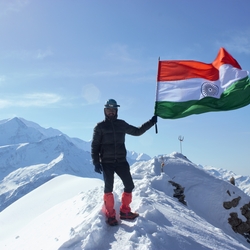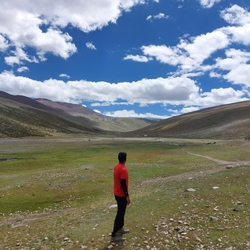Climbing helmets are safety devices that protect climbers in common scenarios that occur during a climb. These include falling rock or ice from above or hitting your head on an ice overhang, thus making them a crucial part of mountaineering gear.
In this article, we explore the different kinds of helmets available, its parts, how to use them and also provide tips on their maintenance.
Different Types of Helmets
Hard Shell Helmets: These helmets help dissipate the force of an impact with the help of the hard outer shell and a webbing suspension system. These are the most durable variant available and also offer different sizing in one helmet. While they offer great protection, they are also heavy and not very well ventilated.
Foam Helmets: These helmets consist of a thick layer of expanded polystyrene (foam) which takes in the impact in case of an accident and coating of a thin layer of polycarbonate on top of the foam which protects the climber from minor bruises and bumps. Foam helmet is the lightest in terms of weight which makes it fragile and also more expensive.
Hybrid Helmets: True to its name, this variant is a hybrid of hard shell and foam helmets. These helmets consist of a thick thermoplastic shell along with some expanded polystyrene. This blend between the two variants offers an all-rounder helmet that has the benefits of being lightweight, durable and affordable all at the same time.
Parts of a Helmet
Most modern helmets have three components:
Outer Shell: This forms the outer shape of the helmet and is the first in the line of defense against an impact or an abrasion.
Foam Liner: This layer heightens the shock absorption and is the part that is directly over the head.
Straps and Suspension: This is attached to the shell, foam liner or both and is the webbing that helps attach the helmet to your head. These straps can be adjusted for better fit as required.

How to Adjust the Helmet to Size
Adjusting the back straps: Open the adjustment fully and place the helmet on your head. Move the dial or webbing in such a manner that it sits at the spot where the skull starts to dive or become less round. Close the webbing to be snug. Ensure that it’s not too tight or too loose.
Adjusting the helmet sides: On either side of the helmet, there are adjustable straps or webbing which should be moved in such a way that your ears are clear of the straps and are not rubbing against them. Ensure that both sides are evenly tensioned so that there is no loose side which could cause the helmet to topple in one direction.
Make sure the helmet is centred: Ensure that the helmet is properly positioned by moving it side to side and see that the fit is snug. The helmet should also cover a portion of the forehead. When this happens, it means that the helmet is sitting over the head and is not lopsided in any direction.
Close the buckle: The webbing closes in through an adjustable buckle on the chinstrap. Lock the buckle and tighten it based on your need. You should be able to slide one finger into the strap after locking and tightening it. The strap should not rub against your skin or feel like it’s choking you.
Functions of a Helmet
A helmet’s main function is to protect the climber against impact and avoid the risk of a serious injury to the head. Wearing helmets insures climbers against loose rock, ice or even equipment that could topple from a climber above. It also avoids serious head injury in the event of a fall or a big swing. Sometimes a climber may stand up too quickly in tight spaces or not notice an overhang of rock or ice. In such instances, helmets protect against bumps and abrasions from the impact. The webbing or straps of the helmet also help distribute the force of an impact, thus reducing the chances of major injuries.
Maintenance and Storage
The following are a few tips for maintaining and storing your climbing helmet in a proper fashion:
- You can paint or label your helmets for easy identification and emergency information but do not place stickers on them. The adhesive could impair the function of the plastic.
- Do not sit or exert any kind of pressure on your helmet.
- Always wear a bandana to protect the helmet against moisture from droplets of sweat.
- Do not use a pressure cleaner to clean your helmet. The pressure results in damage.
- The outer part can be cleaned with a cloth and some rubbing alcohol whereas the inside of the helmet can be washed in lukewarm water with mild soap. Do not use aggressive detergents.
- Ensure that the helmet is fully dry before storing it. Do not dry the helmet in direct sunlight.
- Store the helmet in a dry place with ventilation.
We hope this article gives all the basic and technical information that you might need to know about climbing helmets. Should you have any further queries or doubts, our team is always available to guide you through it!






